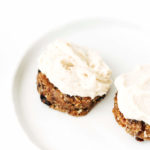Almost Raw Vegan Oatmeal Raisin Cookies with Vanilla Cashew Buttercream
These gluten-free, almost raw vegan oatmeal raisin cookies with vanilla cashew buttercream are downright dreamy. A simple, nearly raw oatmeal cookie base is made with a combination of walnuts, oats, dates, and raisins. This naturally sweetened dough is formed into cookies and slathered with an ultra thick vanilla cashew buttercream. The chewy oatmeal raisin cookie base pairs perfectly with the sweet buttercream icing, making this recipe one for the books.
Servings: 15 cookies
Ingredients
Vanilla Cashew Buttercream
- ¾ cup raw cashews, soaked for at least 2 hours (preferably overnight) and drained
- ½ to ¾ cup Silk Unsweetened Almondmilk
- ½ cup melted coconut butter (it should be runny and pourable—see note*)
- ¼ cup pure maple syrup
- 1 tablespoon coconut flour**
- 1 teaspoon pure vanilla extract or ½ teaspoon vanilla bean powder
- ⅛ teaspoon fine-grain sea salt
No-Bake Oatmeal Raisin Cookies
- 1 cup raw walnuts
- ¾ cup old-fashioned rolled oats
- ¾ cup packed and pitted soft, sticky Medjool dates
- ½ teaspoon pure vanilla extract
- ¼ teaspoon fine sea salt or to taste
- 1 tablespoon filtered water if needed
- ¾ cup raisins
Instructions
For the Vanilla Cashew Buttercream
- Add the soaked cashews and ½ cup of the almond milk to a high-speed blender, and blend on high until smooth, stopping to scrape down the sides as often as needed. If absolutely necessary, add as much of the remaining almond milk, 1 tablespoon at a time, as needed to blend the cashews until smooth. The texture should resemble a very thick cream.
- Add the remaining ingredients and blend for 30 seconds, or until smooth, stopping to scrape down the sides as needed.
- Scoop the icing into a shallow bowl and chill in the freezer for at least 30 minutes to thicken. If you have the time, I recommend chilling for up to 1 hour and vigorously whisking every 10 to 15 minutes (to prevent freezing) to thicken to a fluffy, easily spreadable texture.
For the No-Bake Oatmeal Raisin Cookies
- Add the walnuts and rolled oats to a food processor. Process for 1 minute, or until ground into a coarse meal.
- Add the dates, vanilla, and sea salt. Pulse several times and then process until the dates are thoroughly chopped and the mixture begins to form small, moist clumps. If it's not coming together, add the filtered water and process again. The mixture should be slightly damp and sticky enough to easily hold together when pressed yet able to crumble fairly easily. If needed, add more pitted dates, one at a time, until the mixture begins to gather on one side of the food processor.
- Add the raisins and pulse several times to incorporate and chop into the cookie dough. The dough should appear crumbly yet easily stick together when pressed between your fingers.
- Line a small baking pan with parchment paper. Use a cookie scoop (or small ice cream scoop) to scoop out and compact heaping 1 ½ tablespoon mounds. Drop on the lined pan and repeat.
- Use your fingers to press and compact the balls into round cookies. Freeze for 15 minutes to set.
To Assemble
- One at a time, slather each cookie with a generous amount of the buttercream (if using).***
- Store the cookies, frosted or unfrosted, in the refrigerator for up to 4 days or in the freezer for up to 2 weeks.
Notes
*I find it easiest to make a fresh batch of homemade coconut butter and simply measure off ½ cup while it's still in a liquid state. However, store-bought coconut butter will yield a smoother icing because it's typically much smoother than homemade coconut butter. That said, store-bought coconut butter can be tricky to melt because it scorches and burns easily which leads to a seized, hardened texture. It's also WAY expensive (i.e., $14) compared to homemade, which usually only costs $2–$4 to make.
**Do not substitute the coconut flour. Coconut flour is highly absorbent, much more so than any other flour, which is why it's perfect for thickening this buttercream.
***You'll have quite a bit of leftover buttercream icing (about ⅓ to ½ of the recipe, depending on how generously you frost). I've tried halving the recipe, but it becomes finicky and fussy while blending, so I don't recommend going that route. Fortunately, it freezes well and can be used for a future batch of cookies. Simply scoop any leftover buttercream into an airtight container and freeze for up to 1 month.
